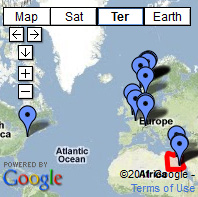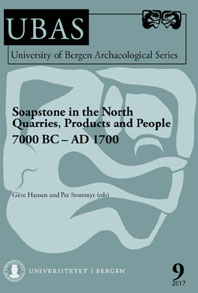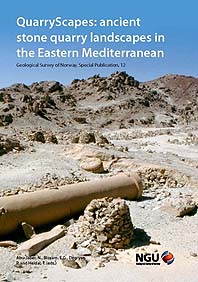
One of the fine Old Kingdom basalt quarries at Widan el-Faras in 2001. Read more to see how it looked like in 2006… Photo: Per Storemyr
Many of you know the Old Kingdom basalt quarries at Widan el-Faras in the Northern Faiyum Desert. Some of you are also familiar with the partial destruction of the quarries by modern basalt quarrying. When we first started to work at Widan, about 12 years ago, in a project headed by Elizabeth Bloxam at UCL, the breathtaking lava and escarpment landscape was still quite pristine. A few years later a substantial part of the quarries had been eaten by machines. Though we had learnt by then that many other quarries in Egypt were under threat from modern development, Widan was a key reason for starting the QuarryScapes project – an EU-funded project on conservation of ancient quarries.
The Widan el-Faras quarries are hard to distinguish, but when you first “see” them, they offer great insight into Old Kingdom “project-driven” stone extraction. This is because the number of individual quarries that was opened here in the 4th and 5th dynasties, together with still-discernible quarry infrastructure, neatly corresponds with the number of pyramid temple floors that was constructed, with the floor by the pyramid of Cheops as the most well-known. It was for temple floors and a few other architectural details that the basalt was mainly used – and this means that quarrying did not take place as a continuous activity over some 150-200 years, but as short-lived campaigns by highly skilled quarriers to get stone for individual projects.
There are four pyramid temple floors made from basalt – and five individual quarries. This discrepancy can be explained by basalt extracted from the fifth quarry that never reached the pyramid fields by the turbulent end of the Old Kingdom. For the basalt was taken out – hundreds of blocks are still present in a specific storage place by the quarries and in the harbour area by the now almost dried-out Faiyum lake (present Lake Qarun). The quarries, storage area and harbour are tied together by a most unusual piece of archaeology: A 12 km long paved road – the earliest paved road in the world. And so the basalt was moved overland down to the old Faiyum Lake and transported on the waterways to the pyramid fields at Giza, Abu Sir and Saqqara (see map below).

And this is how the quarry at Widan el-Faras looked like in 2006, after the bulldozers had done their work. Compare with photo above. Photo: Per Storemyr
No wonder, then, that Widan el-Faras is such a unique and “readable” quarry landscape, certainly to be preserved and worthy of inscription on the World Heritage List. Understandably, but sadly, the old quarries make up a good resource for present building purposes, and so a few individual quarries at Widan el-Faras have already disappeared forever. Many initiatives were taken within the QuarryScapes project (2005-2008) to preserve the quarries and conservation efforts are still going one from time to time. Let’s hope that these quarries and many others in Egypt can be saved for the future! Just now is a very difficult time in Egypt, but recent history has shown that it is exactly in such times that cultural heritage preservation is at its most important.
Want to know more?
Here’s a summary of the series, with links to all the stories: Ten quarries of Ancient Egypt: Series summary
Previous stories on this website:
- A Google Map of the Northern Faiyum Desert
- Egyptian petition: Stop destruction of Lake Qarun Protected Area in the Faiyum!
Much has been written about the archaeology of the Widan el-Faras quarries. Here’s a couple of key papers:
- Harrell, J.A. and Bown, T.M. (1995) An Old Kingdom basalt quarry at Widan el-Faras and the quarry road to Lake Moeris in the Faiyum, Egypt. Journal of the American Research Center in Egypt, 32, 71–91. JSTOR
- Bloxam, E.G. and Storemyr, P. (2002) Old Kingdom basalt quarrying activities at Widan El-Faras, northern Faiyum Desert. Journal of Egyptian Archaeology, 88, 23–36. JSTOR
- Bloxam, E.G. and Heldal, T. (2007) The industrial landscape of the northern Faiyum Desert as a World Heritage Site: modelling the ‘outstanding universal value’ of third millennium BC stone quarrying in Egypt. World Archaeology, 39, 305–323. JSTOR
And please see this paper, with details on destruction and conservation efforts:
- Storemyr, P. (2009): Whatever Else Happened to the Ancient Egyptian Quarries? An Essay on Their Destiny in Modern Times. In: Abu-Jaber, N., Bloxam, E., Degryse, P. & Heldal, T. (eds.): QuarryScapes. Ancient stone quarry landscapes in the Eastern Mediterranean, Geological Survey of Norway Special Publication 12, 105-124. PDF (4,1 MB)
General on Ancient Egyptian quarries:
- Harrell, J.A. & Storemyr, P. (2009): Ancient Egyptian Quarries – An Illustrated Overview. In: Abu-Jaber, N., Bloxam, E., Degryse, P. & Heldal, T. (eds.): QuarryScapes. Ancient stone quarry landscapes in the Eastern Mediterranean, Geological Survey of Norway Special Publication 12, 7-50. PDF (7,6 MB)
The QuarryScapes project:
Map







